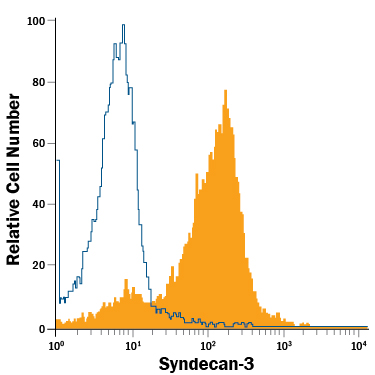Human Syndecan-3 APC-conjugated Antibody Summary
Applications
Please Note: Optimal dilutions should be determined by each laboratory for each application. General Protocols are available in the Technical Information section on our website.
Scientific Data
 View Larger
View Larger
Detection of Syndecan‑3 in A172 Human Cell Line by Flow Cytometry. A172 human glioblastoma cell line was stained with Goat Anti-Human Syndecan-3 APC-conjugated Antigen Affinity-purified Polyclonal Antibody (Catalog # FAB3539A, filled histogram) or isotype control antibody (Catalog # IC108A, open histogram). View our protocol for Staining Membrane-associated Proteins.
Reconstitution Calculator
Preparation and Storage
Background: Syndecan-3
Syndecan-3, also called N-syndecan, is one of four vertebrate syndecans that are principal carriers of heparan sulfate and chondroitin sulfate glycosaminoglycans (GAGs) (1-3). These type 1 transmembrane proteins show conserved cytoplasmic domains and divergent extracellular domains (1-3). Human Syndecan-3 is synthesized as a 442 amino acid (aa) core protein with a 44 aa signal sequence, a 343 aa extracellular domain (ECD), a 21 aa transmembrane (TM) region and a 34 aa cytoplasmic tail with a binding site for PDZ domains (1). The ECD of human Syndecan-3 shares 83%, 83%, 92%, 91% and 91% aa identity with of mouse, rat, equine, bovine and canine Syndecan-3, respectively. Splice isoforms of 384 aa and 346 aa, containing either a 28 aa substitution for aa 1-86 or deletion of aa 1-96, have been reported (4). Syndecan-3 contains four conserved closely-spaced GAG attachment sites near the N-terminus and unique threonine-rich and mucin-like sequences near the membrane (4). Addition of glycan side chains results in an apparent size of 120-150 kDa. Non-covalent homodimerization of Syndecan-3 or, potentially, heterodimerization with Syndecan-2 or -4, is dependent on the transmembrane domain (5). A cleavage site near the TM domain allows shedding of soluble ECD; the remainder of the molecule undergoes regulated intramembrane proteolysis (6). Syndecan-3 is expressed in the nervous system and at limb buds during development (1, 2). It is expressed on neuronal axons and Schwann cell perinodal processes, promoting nerve cell migration and synapse formation (7, 8). Roles in memory and body weight regulation have been described (2, 9, 10). Through localization of growth factors such as FGF2, HGF and TGF-beta, it regulates expression of molecules important for differentiation of muscle and bone, such as myogenin, BMP-2 and hedgehog family members (1, 2, 11-13). In adults, it is upregulated during regeneration, such as following myocardial infarction (14).
- Tkachenko, E. et al. (2005) Circ. Res. 96:488.
- Reizes, O. et al. (2008) Int. J. Biochem. Cell Biol. 40:28.
- Carey, D.J. et al. (1997) J. Biol. Chem. 272:2873.
- ENTREZ protein Accession # O75056, EAX076736 and EAX07637.
- Dews, I.C. and K.R. MacKenzie (2007) Proc. Natl. Acad. Sci. USA 104:20782.
- Schultz, J.G. et al. (2003) J. Biol. Chem. 278:48651.
- Hienola, A. et al. (2006) J. Cell Biol. 174:569.
- Goutebroze, L. et al. (2003) BMC Neurosci. 4:29.
- Kaksonen, M. et al. (2002) Mol. Cell. Neurosci. 21:158.
- Strader. A.D. et al. (2004) J. Clin. Invest. 114:1354.
- Cornelison, D.D.W. et al. (2004) Genes Dev. 18:2231.
- Fisher, M.C. et al. (2006) Matrix Biol. 25:27.
- Pacifici, M. et al. (2005) J. Bone Miner. Metab. 23:191.
- Finsen, A.V. et al. (2004) Physiol. Genomics 16:301.
Product Datasheets
Citations for Human Syndecan-3 APC-conjugated Antibody
R&D Systems personnel manually curate a database that contains references using R&D Systems products. The data collected includes not only links to publications in PubMed, but also provides information about sample types, species, and experimental conditions.
5
Citations: Showing 1 - 5
Filter your results:
Filter by:
-
The Cell Surface Heparan Sulfate Proteoglycan Syndecan-3 Promotes Ovarian Cancer Pathogenesis
Authors: L Hillemeyer, NA Espinoza-S, B Greve, N Hassan, A Chelariu-R, L Kiesel, M Götte
International Journal of Molecular Sciences, 2022-05-21;23(10):.
Species: Human
Sample Types: Whole Cells
Applications: Flow Cytometry -
Contribution of Syndecans to the Cellular Entry of SARS-CoV-2
Authors: A Hudák, A Letoha, L Szilák, T Letoha
International Journal of Molecular Sciences, 2021-05-19;22(10):.
Species: Human
Sample Types: Whole Cells
Applications: Flow Cytometry -
Soluble syndecan-3 binds chemokines, reduces leukocyte migration in vitro and ameliorates disease severity in models of rheumatoid arthritis
Authors: AD Eustace, EF McNaughton, S King, O Kehoe, A Kungl, D Mattey, AH Nobbs, N Williams, J Middleton
Arthritis Res. Ther., 2019-07-12;21(1):172.
Species: Human
Sample Types: Whole Cells
Applications: Flow Cytometry -
Contribution of syndecans to cellular internalization and fibrillation of amyloid-?(1-42)
Authors: T Letoha, A Hudák, E Kusz, A Pettkó-Sza, I Domonkos, K Jósvay, M Hofmann-Ap, L Szilák
Sci Rep, 2019-02-04;9(1):1393.
Species: Human
Sample Types: Whole Cells
Applications: Flow Cytometry -
Molecular mechanisms linking high dose medroxyprogesterone with HIV-1 risk.
Authors: Irvin S, Herold B
PLoS ONE, 2015-03-23;10(3):e0121135.
Species: Human
Sample Types: Whole Cells
Applications: Flow Cytometry
FAQs
No product specific FAQs exist for this product, however you may
View all Antibody FAQsReviews for Human Syndecan-3 APC-conjugated Antibody
There are currently no reviews for this product. Be the first to review Human Syndecan-3 APC-conjugated Antibody and earn rewards!
Have you used Human Syndecan-3 APC-conjugated Antibody?
Submit a review and receive an Amazon gift card.
$25/€18/£15/$25CAN/¥75 Yuan/¥2500 Yen for a review with an image
$10/€7/£6/$10 CAD/¥70 Yuan/¥1110 Yen for a review without an image





